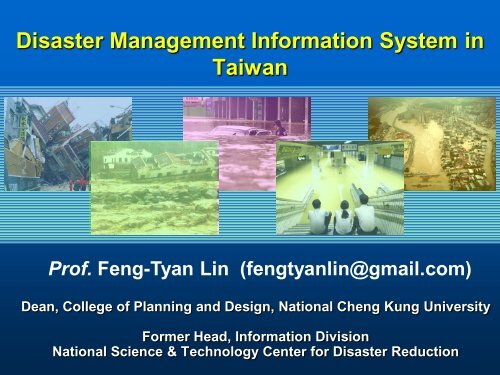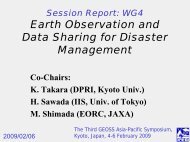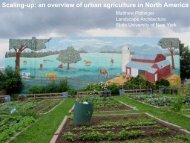Disaster information management system in Taiwan
Disaster information management system in Taiwan
Disaster information management system in Taiwan
You also want an ePaper? Increase the reach of your titles
YUMPU automatically turns print PDFs into web optimized ePapers that Google loves.
<strong>Disaster</strong> Management Information System <strong>in</strong><strong>Taiwan</strong>Prof. Feng-Tyan L<strong>in</strong> (fengtyanl<strong>in</strong>@gmail.com)Dean, College of Plann<strong>in</strong>g and Design, National Cheng Kung UniversityFormer Head, Information DivisionNational Science & Technology Center for <strong>Disaster</strong> Reduction
Contents• Foreword and Background• Organization• Decision Support System for Early Warn<strong>in</strong>g• Risk Map• Resilient Community• Future works
Basic Concepts• Susta<strong>in</strong>ability is an attribute of dynamic, adaptive<strong>system</strong>s that are able to flourish and grow <strong>in</strong> theface of uncerta<strong>in</strong>ty and constant change.• Natural hazards are major threats tosusta<strong>in</strong>ability. They are hard to predict andbecome even worse while global climate changes.• <strong>Disaster</strong> <strong>management</strong> is one of the key issues forachiev<strong>in</strong>g susta<strong>in</strong>ability, which will require<strong>in</strong>novation, foresight, and effective partnershipsamong researchers, governments, corporations,citizens, and other groups.
Basic Information of <strong>Taiwan</strong>•Geographic features•400 km from north to south•145 km from east to west•Area: 36,000 Km 2 over 70% <strong>in</strong>slopeland•Population (<strong>in</strong> June,2006)•22,900,00 <strong>in</strong> total, 67.70% <strong>in</strong>urban areas•Density: 633/ Km 2 , only lowerthan Bangladesh (1023 Km 2 ),higher than Japan (338 Km 2 )•Tectonic Conjunctions:•Philipp<strong>in</strong>e Sea plate•Euro-Asia Plate•High risk of tropical cyclones•3.6 typhoons/year
Summary of <strong>Disaster</strong> Events and PotentialRisks recent years <strong>in</strong> <strong>Taiwan</strong><strong>Disaster</strong>Surround<strong>in</strong>gs‣Urbanization‣ Large-Scale‣Social vulnerable groups‣ Higher-Reoccurrence‣Environmental‣ DiversityDegradation‣ ComplexityVulnerability ‣Global Climate Change• In 2005, the report entitled “Natural <strong>Disaster</strong> Hotspots – AGlobal Risk Analysis” issued by World Bank <strong>in</strong>dicated:“<strong>Taiwan</strong> might be the most vulnerable to natural hazards onEarth, with 73 % of land and population exposed to three ormore hazards”
<strong>Taiwan</strong> Suffers More than Others<strong>Taiwan</strong>Source: World Bank, 2005
Typhoon <strong>Disaster</strong>s <strong>in</strong> <strong>Taiwan</strong>Total loss due to natural disasters (1958-2001)Earthquake8.0%Flood17.4%Other3.3%Typhoon71.4%72% natural hazard damage is causedby typhoon <strong>in</strong> <strong>Taiwan</strong>
Economic Losses of Typhoon <strong>in</strong> <strong>Taiwan</strong>• In average, there are 3.6 typhoons touched down <strong>in</strong><strong>Taiwan</strong> every year• In 2001, 8 typhoons attacked <strong>Taiwan</strong>• In 2004, 6 typhoons swept <strong>Taiwan</strong>• In 2005, 3 category-4 typhoons hit <strong>Taiwan</strong>Typhoon Death InjureAgri.Loss($US M)(A)Constr.Loss($US M)(B)Total($US M)(A+B)Chebi 30 124 22.3 0.7 23.0Trami 5 - 2.2 4.9 7.1Toraji 214 188 235.7 170.6 406.4Typhoon tracks <strong>in</strong> 2001Nari 104 265 126.5 56.7 183.1Utor 1 6 2.9 7.6 10.5Total 354 583 389.6 240.5 630.1
Debris flows and urban flood<strong>in</strong>g have become the most severe hazards<strong>in</strong> <strong>Taiwan</strong> dur<strong>in</strong>g typhoon seasons.Taipei MRT
Organization
Organization Framework ofCurrent <strong>Disaster</strong> Management <strong>in</strong> <strong>Taiwan</strong>Central <strong>Disaster</strong> Prevention& Preparedness CouncilNCDRNational Science councilCivil DefenseOther Counties andTownshipsTechnicalAdvisoryCommitteeCentral <strong>Disaster</strong>Prevention &Response CommitteeDuty M<strong>in</strong>istriesNationalEmergenceOperationsCenterM<strong>in</strong>istry of the Interior, M<strong>in</strong>istry of EconomicAffairs, M<strong>in</strong>istries of Communications, Council ofAgriculture, Environment ProtectionAdm<strong>in</strong>istration, etcCounty County Level <strong>Disaster</strong> Level Prevention <strong>Disaster</strong>& Response Council and DEPCSEmergencyResponseTeam ofM<strong>in</strong>istriesSpecial SAR team andTra<strong>in</strong><strong>in</strong>g CenterSAR teamDepartment of Defense (assistance)NGOs andCommunicationOrganizationTownship Level <strong>Disaster</strong>Prevention & ResponseCouncil and DEPCS
CentralEmergencyOperationCenter
Information flow to the CEOC, <strong>Taiwan</strong>
Information flow to local DMIS
Decision Support Systemfor Early Warn<strong>in</strong>g
• A Decision Support System for Early Warn<strong>in</strong>g (DSSEW)was developed by NCDR for typhoon hazards.• The DSSEW is designed to <strong>in</strong>tegrate the real-timemonitor<strong>in</strong>g data, the dynamic hazard models and Web-GIStechnology to provide disaster <strong>management</strong> decisionsupport tools for early warn<strong>in</strong>g.• The <strong>in</strong>put data of this <strong>system</strong> <strong>in</strong>cludes:• the basic maps• the real-time <strong><strong>in</strong>formation</strong> of typhoon and ra<strong>in</strong>fall issued by theCentral Weather Bureau• the real-time water <strong><strong>in</strong>formation</strong> form the Water ResourcesAgency• the hazard maps <strong>in</strong>dicat<strong>in</strong>g areas of potential landslide, debrisflow and flood<strong>in</strong>g made by NCDR herself• The results of analysis and warn<strong>in</strong>g messages are f<strong>in</strong>allydelivered to the Central Emergency Operations Center(CEOC) and help the commander to make the rightdecisions <strong>in</strong> disaster preparedness and response phases.
Basic MapsRa<strong>in</strong>fall forecast<strong>in</strong>g byCLIPPER modelRa<strong>in</strong>fall forecast<strong>in</strong>g byQPE-SUMS radar <strong>system</strong>Warn<strong>in</strong>g MessageBroadcast<strong>in</strong>gTyphoon PathPredictionInundationPotential MapsReal-Time Water Informationof rivers by Web-ServicesTechnologyAutomatic Estimationof Inundation AreaAnalysis andDecision Mak<strong>in</strong>gDebris Flow andlandslide<strong><strong>in</strong>formation</strong>Automatic Estimation of thepotential areas of DebrisFlows and LandslideManagement of <strong>Disaster</strong>InvestigationCentral Warn<strong>in</strong>gDeclarationNEOC
Function Modules of DSSEWInputInformation forPost-<strong>Disaster</strong> RecoveryBasic MapsHazards MapsReal-Time InformationRa<strong>in</strong>fall Monitor<strong>in</strong>gQPE-SUMS Radar SystemWater InformationCommon Platform forData Shar<strong>in</strong>g<strong>Disaster</strong> Analysis and System IntegrationDataWarehouseMetadataEstablishmentDataStandardizationDataVisualizationManagementOf Softwareand HardwareIntegrated with QPE-SUMSRadar SystemAutomatic Estimation ofInundation AreasAutomatic Estimation of DebrisFlow and Landslide AreasIntegrated with TELES SystemRisk AssessmentRisk Analysis of Toxic SubstanceRelease<strong>Disaster</strong> InvestigationInformation SystemMeteorology DivisionFlood and Drought<strong>Disaster</strong>s Reduction DivisionSlopeland<strong>Disaster</strong> Reduction DivisionEarthquake<strong>Disaster</strong> Reduction DivisionSocio-Economic System DivisionTechnology and Manmade<strong>Disaster</strong>s Reduction DivisionInformation DivisionWeb-GIS (GUI Interface)OutputRa<strong>in</strong>fallForecast<strong>in</strong>gInundationPotentialDebris FlowPotentialDamageAssessmentEarthquakePotentialToxic RiskPotential<strong>Disaster</strong>InvestigationGovernmentalAgencies andNGOsInformationfor EarlyWarn<strong>in</strong>gDecision MakersWEBGISS<strong>in</strong>gle SignonUsers
The System Network of DSSEWBasicDBMetadataDB<strong>Disaster</strong>DBExpertsDB<strong>Disaster</strong> DB<strong>Disaster</strong>Modules<strong>Disaster</strong>KnowledgeDBHTTP, Java, ActiveXWeb APIs, CGI, COM,XML, GML,Web Services (SOAP,UDDI, WSDL)GRIDNetworkProtocolTerm<strong>in</strong>alsUsersInternetDatabaseSystemGISServer<strong>Disaster</strong>ManagementserverNetworkserver<strong>Disaster</strong> ManagementInformation SystemWirelessSystemManagerPost-<strong>Disaster</strong><strong>in</strong>vestigation SystemAnalysts/Decision makers
The Framework Of Common Platform For<strong>Disaster</strong> Information Shar<strong>in</strong>g and ExchangeData Collection ToolsInfo Common PlatformNational Information Center for <strong>Disaster</strong> Reduction<strong>Disaster</strong>DatabaseMetadataDatabase<strong>Disaster</strong>KnowledgeBaseExpertsDatabase<strong>Disaster</strong>OperationsDamageAssessmentRisk Analysise-GovernmentCommon PlatformE-<strong>Taiwan</strong>Common PlatformOtherCommon PlatformXML, GMLNetworkTechnologyCommon PlatformWeb ServicesOS ServicesOpen Netwrok Protocal(SMTP,SOAP, …)XML, GMLXML, GMLXML, GMLMonitor<strong>in</strong>gResponse &Early Warn<strong>in</strong>gPlann<strong>in</strong>ge &ManagementRevovery &Reconstrution…DatabaseCentral Gov.DatabaseE-Ch<strong>in</strong>eseTaipeiDatabaseNCDRDatabaseNGISDatabaseLocal Gov.DatabaseOtherDatabaseInfo. SystemsCentral Gov.Info. SystemsE-Ch<strong>in</strong>ese TaipeiInfo. SystemsNCDRInfo. SystemsLocal Gov.Info. Systems
What is DSSEW do<strong>in</strong>g ?PresentationEmergency responsestrategiessuggestionHazardresponseprocessMonitorRa<strong>in</strong>fall dataClimate forecast modelAnalysisPredict slope landdisaster locationPredict <strong>in</strong>undationdisaster location
MonitorMonitor Real time dataWarn <strong>in</strong>stantlyTyphoon forecastdataRa<strong>in</strong> gauge dataClimate forecast modelSend Warn<strong>in</strong>gmessageRiver and reservoirstatusRadar estimate ra<strong>in</strong>fall•collects the typhoon <strong><strong>in</strong>formation</strong>•estimate of its future track
Severe Weather Early Warn<strong>in</strong>g and Monitor<strong>in</strong>gSatellitesUpper airsound<strong>in</strong>gRegional ModelRadar NetworkData analysisStorm analysisStorm track<strong>in</strong>gRa<strong>in</strong>fall estimateHistorical case...Surface stationsAuto ra<strong>in</strong>-gaugeLighten<strong>in</strong>g observations
Climate forecast modelForecast slope land areara<strong>in</strong>fall by WRF(WeatherResearch & Forecast<strong>in</strong>g model)Forecast Bas<strong>in</strong> ra<strong>in</strong>fall by WRF
The User Interface for the Ra<strong>in</strong>fall DistributionRa<strong>in</strong> gauge ra<strong>in</strong>fall orderThe accumulated ra<strong>in</strong>fall is calculated as the GISlayer
Send warn<strong>in</strong>g message to cell phonesDynamicRa<strong>in</strong>falldatabaseCalculateaccumulate 1、3hours ra<strong>in</strong>fall ofeach ra<strong>in</strong> gaugeRa<strong>in</strong>fall warn<strong>in</strong>g ruleTwo adjacent ra<strong>in</strong> gaugeexceed 40mm/hrS<strong>in</strong>gle ra<strong>in</strong> gaugeexceed 100mm/hrMake message listSend message(May) 27 04:10Taitung county DaRan town NanTianaccumulate 1 hour ra<strong>in</strong>fall 43mmTaitung county DaRan town Shoukaaccumulate 1 hour ra<strong>in</strong>fall 45mm
AnalysisStatic basic dataReal timehazard dataBasic map dataPredict slope landdisaster locationPotential <strong>in</strong>undationdataReveal hazard locationPotential debris flowdataPredict <strong>in</strong>undationdisaster location
Real Time Ra<strong>in</strong>fallDataTyphoon PathPredictionMeteorologicalmodelsflood areasDatabaseCaseRetrievalDetailmeteorological mapLandslideDatabaseReal-timeflood<strong>in</strong>g areaPotential floodarea predictionPotential landslidearea predictionLandslide disasterresponse <strong>system</strong>Socio-economicLosses predictionTransportation<strong>system</strong>National<strong>Disaster</strong> Response Center
The Inundation Potential Maps <strong>in</strong> <strong>Taiwan</strong>• The flood and droughtmitigation research grouphad f<strong>in</strong>ished the island-wide<strong>in</strong>undation potential maps <strong>in</strong>2001.• For floodpla<strong>in</strong> <strong>management</strong>s• For flood mitigations• Incorporation with socialeconomic<strong><strong>in</strong>formation</strong>Taipei CityDepth : m0.50 - 1.501.50 - 2.502.50 - 3.503.50+Kaohsiung City
Select<strong>in</strong>g Potential Inundation AreasRiverCounty boundaryTownship boundaryHighwayMajor roadReal-time Ra<strong>in</strong>fall Records+Flood PotentialRa<strong>in</strong>fall Forecast<strong>in</strong>gHighest (avg. depth > 1.5 m)Higher (avg. depth 1.0m – 1.5m)High (avg. depth 0.5m – 1.0 m)Automatically selects the <strong>in</strong>undation potential layers every 10 m<strong>in</strong>utes32
Forecast<strong>in</strong>g of the Inundation Potential AreasBe modified manually via the user <strong>in</strong>terface of DSSER33
Potential Streams of Debris FlowGeology Zon<strong>in</strong>g of 1420Potential Hazard StreamsAutomatically identifies the potential areas of debris flow and landslide every one hour34
Issues the Warn<strong>in</strong>g and Security for the Counties ofthe Slopeland <strong>Disaster</strong> VulnerabilityMeteorological dataRa<strong>in</strong>fall distributionForecast ra<strong>in</strong>fall distributionThresholdSlopeland disaster thresholdForecast disaster locations<strong>Disaster</strong> location of the sametyphoon track<strong>in</strong>g before vs.ra<strong>in</strong>fall distributionSlopeland disaster VulnerabilityForecast traffic <strong>in</strong>terruptionlocationNoAccumulative ra<strong>in</strong>fall R(unit: mm)Averaged ra<strong>in</strong>fall <strong>in</strong>tensityI avg = R/D (unit: mm/hr)Start of a ra<strong>in</strong>fall event (t 1)(unit: hr)Current time (t 2)(unit: hr)Ra<strong>in</strong>fall duration D = t 2-t 1(unit: hr)I avg> I cYesDebris flow threshold l<strong>in</strong>eI c = 115.47D I -0.8c(unit: mm/hr)Display streams and regions over threshold <strong>in</strong> WebGISJudgments of regions prone to debris flowWarn<strong>in</strong>g of debris flow prone areas
The User Interface for the Forecast<strong>in</strong>g ofthe Slopeland <strong>Disaster</strong> Locations
PresentationImage and3D land form dataDecision mak<strong>in</strong>gCentralEmergencyOperationsCenterInformationdashboardResponse andarrange resource3D demonstration
Early Warn<strong>in</strong>g System for Decision MakerTyphoon Forecast<strong>in</strong>gRouteDistribution of Ra<strong>in</strong>fallRa<strong>in</strong>fall PeriodInundationPotential areasLandslidePotential areasSuggestion38
Risk Map
Climate-Related Inundation Risk MapRisk (R) = Hazard (H) x Vulnerability (V)R = Risk <strong>in</strong>dexH = Natural hazardsra<strong>in</strong>fall, <strong>in</strong>undation, land subsidenceV = Social vulnerabilitypopulation, age, <strong>in</strong>come, education, mortality
countytownship<strong>in</strong>dexRisk Indexra<strong>in</strong>fall<strong>in</strong>undationLandsubsidenceSocialVulneability屏 東 縣 林 邊 鄉 103.25 4.20 3.46 2.20 3.90 1.15台 南 縣 永 康 市 96.90 3.64 2.40 2.08 3.08 2.54雲 林 縣 大 埤 鄉 86.45 2.46 2.79 3.27 4.15 1.16屏 東 縣 東 港 鎮 85.54 4.06 3.75 1.62 3.74 1.37雲 林 縣 褒 忠 鄉 84.97 2.52 2.29 4.19 4.04 1.11高 雄 市 三 民 區 84.56 4.31 2.11 1.29 2.76 3.61雲 林 縣 台 西 鄉 83.69 2.59 2.72 2.79 4.27 1.20彰 化 縣 大 城 鄉 78.36 2.67 1.48 5.00 4.46 1.14雲 林 縣 四 湖 鄉 76.82 2.73 2.48 2.73 4.39 1.20雲 林 縣 崙 背 鄉 76.39 2.80 2.05 3.87 4.04 1.20population
Mitigation Strategiesra<strong>in</strong>fall <strong>in</strong>undation LandsubsidenceSocialvulnerabilitypopulation彰 雲 嘉 沿 海地 區(coastalarea)高 雄 台 南 都會 區(metropolitanarea)○ + + + -+ ○ - - +高 屏 沿 海 區(coastalarea)+ + - + -Different areas need different mitigation strategies
Overlaid withnational constructionprojects
Resilient Community
》 The limitation of government’s capability》The importance of community capabilityCENTRALGOV.COUNTY GOV.TOWNSHIP GOV.COMMUNITY》 The Hyogo Framework for Action 2005-2015“build<strong>in</strong>g disaster resilient community”
FROM RESISTANCE TO RESILIENCECommunity-Based <strong>Disaster</strong> Management Plan1.The Chi-Chi Earthquake Community Recovery2.Community Empowerment for <strong>Disaster</strong> ManagementWith “bottom up” participation of public sectors,experts and community-based organizations toimprove pre-disaster plann<strong>in</strong>g, facilitat<strong>in</strong>gpreparedness and emergency responsecapability.
CBDM PLAN《Participatory Process》
》Field survey
schoolCommunity meet<strong>in</strong>gchurchPeople to people
A Full-scale Exercise of Evacuation
Community-based recovery—Tau-Mi Village
Future works
Future works (1/2)• Susta<strong>in</strong>able city-regions should be built up for empower<strong>in</strong>gcommunity resilience.• Human factors should be further studied and elaborated.Communications and <strong>in</strong>terpretations among researchers,governmental officers, NGOs, NPOs, local communities, andgeneral citizens, should be greatly improved.• Urban space should be <strong>in</strong>novatively re-structured.Resolutions should be sought to balance economic growthand disaster risks.• Information <strong>system</strong> is an essential component for disasterreduction and emergency <strong>management</strong>. The disaster<strong>management</strong> <strong><strong>in</strong>formation</strong> <strong>system</strong> should be graduallyupgraded to a real decision support <strong>system</strong>, where more<strong>in</strong>telligent reason<strong>in</strong>g and prediction models should be<strong>in</strong>stalled together. Bi-directional emergency <strong><strong>in</strong>formation</strong>exchange and check mechanism should be built up.
Future works (2/2)• Many organizations, <strong>in</strong>clud<strong>in</strong>g fire, weather, water,and soil agencies, <strong>in</strong> different levels of governments<strong>in</strong> <strong>Taiwan</strong> have had their own emergency <strong><strong>in</strong>formation</strong><strong>management</strong> <strong>system</strong>s. The further step for hav<strong>in</strong>g an<strong>in</strong>tegrated DSSEW is to tightly work with the NGISprogram, team up the <strong><strong>in</strong>formation</strong> divisions ofassociate research centers, establish a datawarehouse as a common platform with an XML/GMLbaseddata exchange standards, and jo<strong>in</strong><strong>in</strong>ternational cooperation projects.• It is highly expected that we will have a moresuccessful emergency response and disasterreduction <strong>system</strong> if we are able to fully employ thepowerful capability of computer <strong>system</strong>s, web-basedtechnology, and telecommunications devices.
Thank youfor your attention!!!







